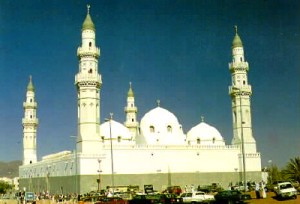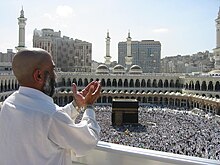Mosque

Converting a Mosque to a Church in Reconquista Spain
Quba Mosque in Medina is reportedly the oldest mosque in the world.
A mosque (/mɒsk/; Arabic: مسجد masjid, plural مساجد masājid), sometimes spelt mosk, is a place of worship for followers of Islam.
There are strict and detailed requirements in Sunni fiqh for a place of worship to be considered a mosque, with places that do not meet these requirements regarded as musallas. There are stringent restrictions on the uses of the area formally demarcated as the mosque (which is often a small portion of the larger complex), and, in the Islamic Sharia law, after an area is formally designated as a mosque, it remains so until the Last Day.
Many mosques have elaborate domes, minarets, and prayer halls, in varying styles of architecture. Mosques originated on the Arabian Peninsula, but are now found in all inhabited continents. The mosque serves as a place where Muslims can come together for salat (صلاةṣalāt, meaning “prayer”) as well as a center for information, education, and dispute settlement. The imam leads the congregation in prayer.
Etymology
The word entered English from a French word which probably derived from Italian moschea, a variant of Italian moscheta, from either Armenian մզկիթ (mzkiṭ) or Greek μασγίδιον (masgídion) or Spanish mesquita, from the Arabic مسجد masjid meaning “place of worship” or “prostration in prayer”, either from Nabataean masgĕdhā́ or from Arabic سجد sajada meaning “to bow down in prayer” or “worship,” probably ultimately from Aramaic sĕghēdh.
History
The Masjid al-Haram was one of the first mosques, and today is considered the holiest site in Islam
The Great Mosque of Kairouan, in Tunisia, is the oldest mosque in the Muslim West.
The first mosque in the world is often considered to be the area around the Kaaba in Mecca now known as the Masjid al-Haram. Since as early as 638 AD, the Masjid al-Haram has been expanded on several occasions to accommodate the increasing number of Muslims who either live in the area or make the annual pilgrimage known as hajj to the city. Others regard the first mosque in history to be the Quba Mosque in present-dayMedina since it was the first structure built by Muhammad upon his emigration from Meccain 622.
Muhammad went on to establish another mosque in Medina, which is now known as the Masjid an-Nabawi, or the Prophet’s Mosque. Built on the site of his home, Muhammad participated in the construction of the mosque himself and helped pioneer the concept of the mosque as the focal point of the Islamic city. The Masjid al-Nabawi introduced some of the features still common in today’s mosques, including the niche at the front of the prayer space known as the mihrab and the tiered pulpit called the minbar. The Masjid al-Nabawi was also constructed with a large courtyard, a motif common among mosques built since then.
Diffusion and Evolution
Mosques had been built in Iraq and North Africa by the end of the 7th century, as Islaam spread outside the Arabian Peninsula with early caliphates. The Imam Husayn Shrine in Karbala is reportedly one of the oldest mosques in Iraq, although its present form – typical of Persian architecture – only goes back to the 11th century. The shrine, while still operating as a mosque, remains one of the holiest sites for Shia Muslims, as it honors the death of the third Shia imam, Hussein ibn Ali. The Mosque of Amr ibn al-As was reportedly the first mosque in Egypt, serving as a religious and social center for Fustat (present-day Cairo) during its prime. Like the Imam Husayn Shrine, though, nothing of its original structure remains. With the later Fatimid Caliphate, mosques throughout Egypt evolved to include schools (known as madrasas), hospitals, and tombs.
The Great Mosque of Kairouan in present-day Tunisia was reportedly the first mosque built in northwest Africa, with its present form (dating from the 9th century) serving as a model for other Islaamic places of worship in the Maghreb. It was the first to incorporate a square minaret (as opposed to the more common circular minaret) and includes naves akin to a basilica. Those features can also be found in Andalusian mosques, including the Grand Mosque of Cordoba, as they tended to reflect the architecture of the Moors instead of their Visigoth predecessors. Still, some elements of Visigothic architecture, like horseshoe arches, were infused into the mosque architecture of Spain and the Maghreb.
The first mosque in East Asia was reportedly established in the 8th century in Xi’an. However, the Great Mosque of Xi’an, whose current building dates from the 18th century, does not replicate the features often associated with mosques elsewhere. Indeed, minarets were initially prohibited by the state. Following traditional Chinese architecture, the Great Mosque of Xi’an, like many other mosques in eastern China, resembles a pagoda, with a green roof instead of the yellow roof common on imperial structures in China. Mosques in western China were more likely to incorporate elements, like domes and minarets, traditionally seen in mosques elsewhere.
A similar integration of foreign and local influences could be seen on the Indonesian islands of Sumatra and Java, where mosques, including the Demak Great Mosque, were first established in the 15th century. Early Javanese mosques took design cues from Hindu, Buddhist, and Chinese architectural influences, with tall timber, multi-level roofs similar to the pagodas of Balinese Hindu temples; the ubiquitous Islamic dome did not appear in Indonesia until the 19th century. In turn, the Javanese style influenced the styles of mosques in Indonesia’s Austronesian neighbors—Malaysia, Brunei, and the Philippines.
Jama Masjid in Delhi remains India’s largest mosque and a classic example of the Mughal style of architecture.
Muslim empires were instrumental in the evolution and spread of mosques. Although mosques were first established in India during the 7th century, they were not commonplace across the subcontinent until the arrival of the Mughals in the 16th and 17th centuries. Reflecting their Timurid origins, Mughal-style mosques included onion domes, pointed arches, and elaborate circular minarets, features common in the Persian and Central Asian styles. The Jama Masjid in Delhi and the Badshahi Mosque in Lahore, built in a similar manner in the mid-17th century, remain two of the largest mosques on the Indian subcontinent.
The Umayyad Caliphate was particularly instrumental in spreading Islaam and establishing mosques within the Levant, as the Umayyads constructed among the most revered mosques in the region—the al-Aqsa Mosque and Dome of the Rock in Jerusalem and the Umayyad Mosque in Damascus. The designs of the Dome of the Rock and the Umayyad Mosque were influenced by Byzantine architecture, a trend that continued with the rise of the Ottoman Empire. Several of the early mosques in the Ottoman Empire were originally churches or cathedrals from the Byzantine Empire, with the Hagia Sophia (one of those converted cathedrals) informing the architecture of mosques from after the Ottoman conquest of Constantinople. Still, the Ottomans developed their own architectural style characterized by large central rotundas (sometimes surrounded by multiple smaller domes), pencil-shaped minarets, and open facades.
The Shah Jahan Mosque, built in 1889, was reportedly the first mosque in the United Kingdom; today, the country has more than 1,500.
Mosques from the Ottoman period are still scattered across Eastern Europe, but the most rapid growth in the number of mosques in Europe has occurred within the past century as more Muslims have migrated to the continent. Many major European cities are home to mosques, like the Grand Mosque of Paris, that incorporate domes, minarets, and other features often found with mosques in Muslim-majority countries. The first mosque in North America was founded by Albanian Americans in 1915, but the continent’s oldest surviving mosque, the Mother Mosque of America, only dates back to the 1930’s. As in Europe, the number of American mosques has rapidly increased in recent decades as Muslim immigrants, particularly from South Asia, have come in the United States. Greater than forty percent of mosques in the United States were constructed after 2000.
Conversion of non-Muslim places of worship into mosques
According to early Muslim historians, towns that surrendered without resistance and made treaties with the Muslims gave the Muslims permission to take their churches and synagogues. One of the earliest examples of these kinds of conversions was in Damascus, Syria, where in 705 Umayyad caliph Al-Walid I bought the church of St. John from the Christians and had it rebuilt as a mosque in exchange for building a number of new churches for the Christians in Damascus. Overall, Abd al-Malik ibn Marwan (Al-Waleed’s father) is said to have transformed 10 churches in Damascus into mosques.
The process of turning churches into mosques was especially intensive in the villages where most of the inhabitants converted to Islam. The Abbasid caliph al-Ma’mun turned many churches into mosques. Ottoman Turks converted nearly all churches, monasteries, and chapels in Constantinople, including the famous Hagia Sophia, immediately after capturing the city in 1453 into mosques. In some instances mosques have been established on the places of Jewish or Christian sanctuaries associated with Biblical personalities who were also recognized by Islam.
Mosques have also been converted for use by other religions, notably in southern Spain, following the conquest of the Moors in 1492. The most prominent of them is the Great Mosque of Cordoba. The Iberian Peninsula and southeast Europe are other regions in the world where such instances occurred once no longer under Muslim rule.







